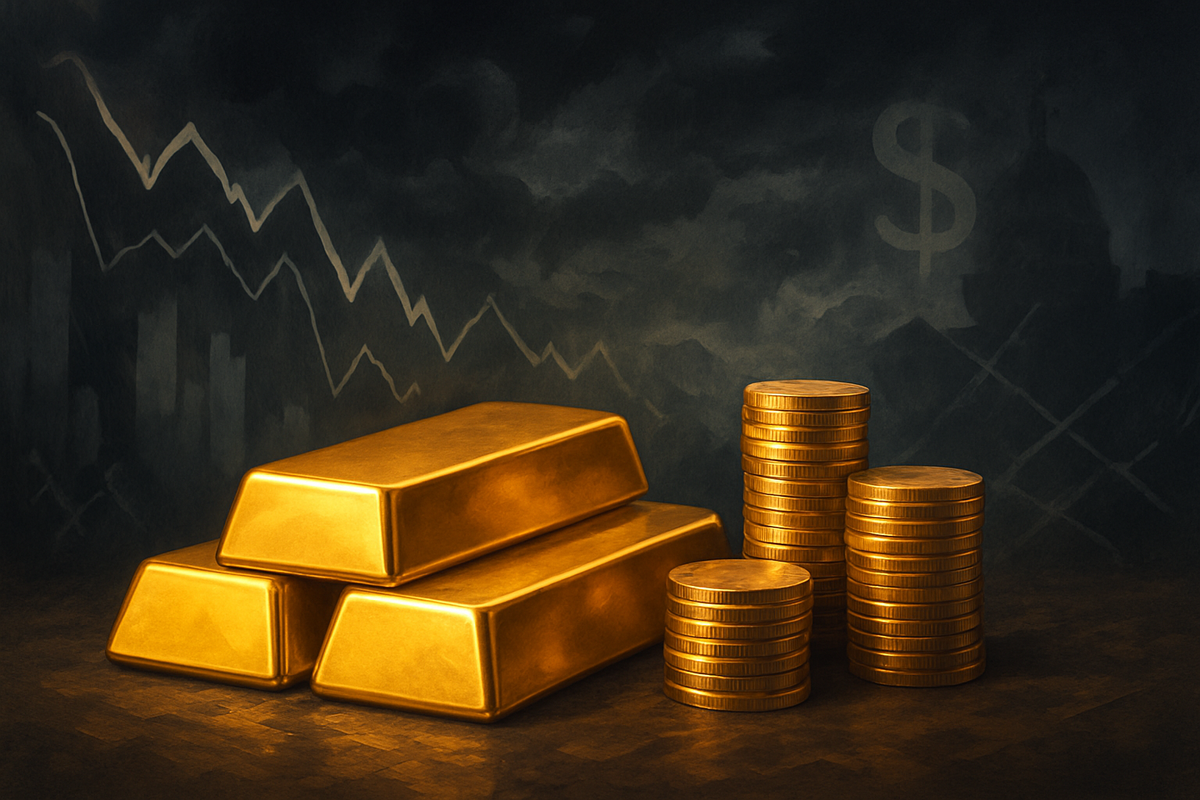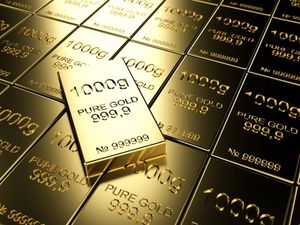
Gold prices are currently hovering just shy of an unprecedented $4000 per ounce as of November 6, 2025, a dramatic surge driven by a confluence of factors: a prolonged and historic US government shutdown, persistent tariff uncertainty, and a notably weaker US dollar. This remarkable ascent underscores gold's enduring role as a critical safe-haven asset, reflecting deep-seated anxieties across global financial markets and signaling a profound shift in investor sentiment towards tangible stores of value.
The precious metal's rally is not merely a fleeting reaction but a sustained response to a landscape fraught with economic and political instability. The ongoing US government shutdown, now the longest in the nation's history, has paralyzed federal operations and injected immense uncertainty into the economic outlook. Simultaneously, the specter of escalating trade wars and new tariffs continues to cast a long shadow over global supply chains and corporate profitability. This dual threat has prompted a significant flight to safety, with investors increasingly abandoning riskier assets in favor of gold's perceived stability. The weakening US dollar further amplifies gold's appeal, making the dollar-denominated commodity more attractive to international buyers and reinforcing the metal's status as a hedge against currency debasement.
Unpacking the Crisis: A Timeline of Turmoil
The current market dynamics are a direct consequence of a series of escalating political and economic events throughout 2025.
The most significant immediate driver is the ongoing US government shutdown, which commenced on October 1, 2025. As of November 6, 2025, this shutdown has surpassed all previous records, extending beyond 35 days. The stalemate in Congress over federal funding has led to the furlough of millions of federal employees, the suspension of critical government services, and, crucially, the cessation of vital economic data releases. This data vacuum has left investors and policymakers operating in the dark, further fueling market uncertainty. Initial market reactions saw gold prices rally significantly, with spot gold hitting a record $3,858.45 per troy ounce in early October and futures climbing towards $3,900. By November, gold had breached the $4,000 mark. The US Dollar Index (DXY) experienced an initial dip on October 1st, and while it showed some resilience, the prolonged shutdown has generally contributed to a bearish sentiment for the dollar.
Adding to the instability are persistent tariff uncertainties, largely stemming from the Trump administration's trade policies. The US-China trade war, initiated in 2018, has seen renewed tensions and new tariff announcements in 2025. President Trump has continued to signal plans for additional tariffs, including a proposed 10% tariff on Chinese goods, effectively doubling duties imposed earlier in February 2025. Notably, a specific event around July 31, 2025, saw temporary confusion regarding a 39% tariff on gold bars from Switzerland, causing gold futures to spike to record highs before clarification. These tariff policies, which have pushed the US average effective tariff rate to 18.6% (the highest since 1933), create inflationary pressures and disrupt global supply chains. Gold has historically thrived during such periods of trade friction, performing strongly in 2019 during the initial US-China trade war and continuing its ascent throughout 2025 as trade tensions mounted. The uncertainty surrounding these policies, including a Supreme Court review of presidential tariff authority, continues to bolster gold's safe-haven appeal.
Winners and Losers: Corporate Fortunes in a Tumultuous Market
The current climate of rising gold prices, government dysfunction, and trade disputes creates a clear divide between companies poised to benefit and those facing significant headwinds.
Gold mining companies are the unequivocal winners in this scenario. With gold prices soaring near $4000 per ounce, their revenue per extracted ounce dramatically increases, leading to expanded profit margins, improved cash flow, and often higher dividend payouts. Companies like Newmont Corporation (NEM), the world's largest gold producer, have seen their stock rise significantly in 2025, supported by record free cash flow. Barrick Gold Corporation (GOLD) and Agnico Eagle Mines Limited (AEM) are also well-positioned to capitalize on elevated prices, with strong financial performance and strategic growth initiatives. Precious metals streaming and royalty companies such as Franco-Nevada Corporation (FNV) and Wheaton Precious Metals Corp. (WPM) also benefit, offering leveraged exposure to gold prices without the direct operational risks of mining. These companies are likely to see improved balance sheets, opportunities for debt reduction, and increased shareholder returns.
Conversely, several sectors face considerable challenges. Government contractors, particularly small and mid-sized businesses heavily reliant on federal contracts, are immediate losers from the US shutdown. They face revenue gaps, payment suspensions, and potential layoffs, with no guarantee of backpay for their employees. Larger defense contractors with existing funded programs may be less affected initially but still face delays in new contract awards. Companies requiring regulatory approvals, especially in highly regulated industries like biopharmaceuticals and finance, are also severely impacted. Agencies like the FDA and SEC, operating with furloughed staff, cannot process permits, licenses, or drug approvals, halting crucial growth milestones and product launches. This uncertainty negatively affects investor confidence and stock valuations.
Furthermore, industrial and manufacturing companies with complex global supply chains are acutely vulnerable to tariff uncertainties. Businesses reliant on imported raw materials or components from tariff-hit regions face increased input costs, squeezing profit margins and potentially necessitating price increases that hurt demand. Companies like Caterpillar (CAT) and John Deere (DE), manufacturers of heavy machinery, face higher input costs. Retail giants such as Walmart (WMT) and Target (TGT), heavily importing goods, fear severe supply chain disruptions and increased logistics costs. Tech companies like Apple (AAPL), Amazon (AMZN), and Nvidia (NVDA) with manufacturing facilities in China and other affected regions also face substantial challenges, as tariffs disrupt demand forecasting and inventory planning, impacting stock performance and overall business outlook.
Wider Significance: A System Under Stress
Gold's dramatic ascent as a safe-haven asset, propelled by the ongoing US shutdown and tariff uncertainty, is more than just a market anomaly; it signifies a profound recalibration of risk perception within the global financial system. This event fits into broader industry trends marked by an erosion of confidence in traditional financial instruments and a strategic shift towards tangible assets.
The sustained and record-breaking central bank demand for gold, particularly from emerging economies like China, underscores a broader trend of de-dollarization and a strategic effort to manage geopolitical risks. Gold holdings are less susceptible to sanctions than foreign currency reserves, making them an attractive hedge against an increasingly fragmented geopolitical landscape. This institutional validation of gold's role as a reserve asset significantly bolsters its long-term appeal. Moreover, the pervasive "risk-off" sentiment dominating markets, fueled by concerns over potentially overvalued equity markets (especially in the technology and AI sectors), macroeconomic uncertainties, and escalating geopolitical tensions, further solidifies gold's position as an "anti-fragile asset" capable of thriving amidst chaos.
The ripple effects of this situation are widespread. While gold and other precious metals like silver benefit, risk assets, particularly high-growth technology and AI stocks, face capital rotation away from them. The US dollar's status as an undisputed safe haven has been challenged, with its weakening trend making gold more attractive. For gold mining companies, this translates into increased exploration and production activities, while gold-consuming industries like jewelry manufacturing face significant cost pressures. Globally, nations with substantial gold reserves see their assets appreciate, providing a buffer against economic shocks.
From a regulatory and policy standpoint, the prolonged government shutdown complicates the Federal Reserve's monetary policy decisions, potentially delaying anticipated interest rate cuts due to a lack of complete economic data. This data vacuum creates an "operating blind" environment for policymakers. The Supreme Court's review of presidential tariff authority also highlights the critical policy implications of trade disputes, which will shape future trade policies, inflation dynamics, and the resilience of global supply chains. Regulators may also increase scrutiny on market liquidity and leverage, especially in sectors perceived as overvalued.
Historically, gold has consistently surged during periods of profound uncertainty. The 1970s, marked by stagflation and geopolitical turmoil, saw gold's value soar. The aftermath of the 2008 Global Financial Crisis and more recent geopolitical conflicts have similarly underscored gold's reliability as a hedge. While shorter government shutdowns have had limited impact, the current historically prolonged shutdown suggests a more pronounced effect. The current tariff rates and trade tensions are described as having no modern precedent, intensifying the flight to safety and drawing parallels to historical trade hostilities like the Smoot-Hawley Tariff Act of 1930, which led to severe economic declines.
What Comes Next: Navigating the Uncertain Path Ahead
The coming months will be pivotal in determining the trajectory of gold prices and the broader financial markets. The interplay between the resolution of the US government shutdown, the evolution of tariff policies, and central bank responses will shape the economic landscape.
In the short-term, gold is likely to remain highly sensitive to news regarding the shutdown and tariff negotiations. A swift resolution to the government shutdown, while providing a temporary boost to broader markets, might see a slight retreat in gold prices as the immediate crisis premium diminishes. However, if tariff uncertainties persist, keeping inflation elevated and supply chains under pressure, gold's underlying support will likely remain strong, potentially leading to renewed gains. For investors, maintaining a diversified portfolio with an allocation to safe-haven assets like gold is crucial. Businesses should prioritize supply chain resilience, diversifying away from tariff-hit regions and adopting flexible operating models to adapt to rapid changes.
Looking at the long-term, the outlook for gold remains bullish as long as economic uncertainty, trade tensions, and potential inflationary pressures persist. Central banks' continued acceleration of gold purchases as a reserve asset to diversify currency exposures further underpins its sustained demand. Gold's role as a monetary metal, rather than just a commodity, reinforces its long-term value preservation capabilities. For investors, this suggests gold could continue to be a valuable component for wealth preservation, with potential for further gains if global growth concerns mount and central banks respond with accommodative monetary policies.
Several scenarios could unfold. A "quick resolution, persistent tariffs" scenario sees the shutdown end, but trade tensions linger, keeping gold supported by inflation concerns. A "prolonged dysfunction and escalating trade war" scenario, the worst case, would likely trigger a severe economic slowdown or recession, leading to a strong, sustained rally in gold as a primary safe haven. Conversely, a "compromise and de-escalation" scenario, the best case, would see both the shutdown and tariff tensions ease, leading to a rebound in equities and a potential initial retreat in gold prices, though underlying inflationary pressures could still provide support.
Strategic pivots for investors include focusing on diversification, avoiding emotional decisions based on short-term volatility, and monitoring key indicators such as the shutdown's duration, economic data releases, and central bank policies. Businesses should build cash reserves, explore "in U.S. for U.S." production strategies to mitigate tariff impacts, and engage proactively with trade counsel. Emerging markets face challenges from trade damage and potential capital outflows but also opportunities if the US dollar weakens, allowing for more monetary flexibility and potentially higher commodity prices.
A Comprehensive Wrap-Up: Navigating the New Normal
The current financial landscape, dominated by a historic US government shutdown and pervasive tariff uncertainty, has unequivocally cemented gold's status as a critical safe-haven asset. Its surge towards $4000 per ounce is a stark indicator of profound global unease, reflecting investor flight from risk and a search for stability amidst political deadlock and economic fragmentation.
Moving forward, the market will remain highly sensitive to political developments in Washington and the trajectory of global trade relations. Investors should prepare for continued volatility and consider gold as a fundamental component of a resilient portfolio, offering a hedge against both economic downturns and inflationary pressures. The weakening US dollar and sustained central bank demand further bolster gold's long-term appeal.
Key takeaways include the erosion of confidence in traditional financial instruments, the strategic shift towards tangible assets, and the increasing importance of diversification. Investors should watch for signs of resolution in the US government shutdown, any de-escalation or escalation of tariff policies, and the Federal Reserve's monetary policy responses. The lasting impact of these events will likely redefine risk perceptions and investment strategies for years to come, with gold poised to maintain its prominence as a beacon of stability in an uncertain world.
This content is intended for informational purposes only and is not financial advice





